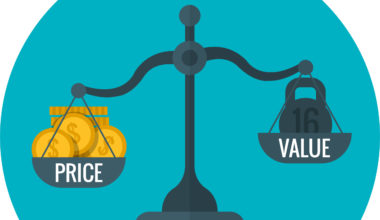When it comes to closing big deals, how you present the deal makes all the difference in the world. Now we must package all of our hard work (see article parts 2 through 5) into a straightforward, easily digestible narrative that sells itself to the customer.
Let’s recap our work to date: we’ve learned our client’s objectives, and we took their objectives, matched them to our value proposition, and estimated the value our client receives from our product numerically. We used our estimates to construct value multiplying long-term deal options, and we even built-in safeguards to increase our client’s comfort level.
I have five guidelines for presenting big deals:
- Keep your presentation simple: prepare a focused deck with ~3 to 4 slides that clarify the value of the long-term deal options.
- Build an appendix with reinforcement slides: try to predict your customer’s questions and put together reinforcement slides for your appendix. The appendix is also the perfect place for your complex slides (detailed calculations, visuals, and more).
- Build a deck that “sells itself” to the invisible decision-maker: salespeople never talk to the final decision-maker in many cases. Often, we must rely on our day-to-day client contacts to present our narrative to the CFO/CRO/CEO or another executive for their approval. Make it as easy as possible for your contact to re-explain the deal options to others.
- Agree on talking points with any co-presenters: if you’re presenting your deal with another person, whether it’s a product lead or your VP of sales, you must agree precisely on what each of you will discuss during the presentation. Avoid surprises and potential talk tracks that undermine your narrative.
- Practice: practice your presentation at least three times. Record yourself on video or use the voice memos app on your phone. Practicing will make everything much smoother, and you’ll exude confidence. For team presentations, practice together. To take it to another level, pitch to a colleague and have them role-play as a demanding customer to practice your objection handling.
Picking up our previous example of an HR SaaS product (see part 2), imagine that we’ve reached out to the client and booked a presentation to walk through the deal options next week. Now it’s time to get to work building our presentation and distilling all of the work we’ve done into a handful of slides. Let’s start by outlining the points we want to get across in our deck:
- Our SaaS HR product is helping our client to reduce costs by reducing headcount, fines, and legal fees; this aligns with their goals for 2021.
- Our client saves between $1.26M and $2.53M per year, and our fee is $252K annually.
- Our client’s overall ROI (return-on-investment) from our software is roughly 6.5x.
- Our client is currently purchasing our software on a month-to-month plan, and if they commit to a one-year or two-year deal, we’ll cut their monthly price and provide additional value.
- Their ROI increases to 8.5x for one year and 11.3x for two years with the commitment.
- To increase their comfort with signing for two years, we’ll hire a 3rd party consultant to evaluate our impact at the one-year mark and provide the client an out if the results are below our low estimate.
Now let’s distill this information into a simple set of slides. In this case, because this is a current client, we’re going to use a where we are now, where we could be framework. Here is a sample deck:
Note that where it says "your company" in the deck in italics would typically be your client's name.
The narrative in this deck begins on slide two by recapping the benefit obtained from our companies product (where we are now) and reinforcing the growing need heading into the future. By starting with the savings and ROI estimates, you may receive immediate feedback from your client. If they question the estimates, you can jump to the appendix (slide 7) that explains the numbers in more detail. It is vital that the client feels comfortable with your estimates before introducing the long-term deal options.
Slide three (where we could be) introduces the deal options, focusing on the ROI first and the reduced pricing per month with the larger deals. It also allows you to present the additional value provided, including locked-in pricing and the 3rd party mid-point evaluation (with selective termination). Slide four focuses on the new products introduced with the long-term agreement: quarterly HR compliance training and semi-annual legal risk review.
The narrative concludes on slide five by outlining the next steps and reinforcing that the deal aligns perfectly with the customer’s 2022 objectives. The conclusion also sets two expectations: when the client will provide feedback and how to implement the long-term agreement logistically. When you arrive at this slide, briefly discuss the summary and ask the client their opinion. It can be as simple as “what do you think?” The vast majority of the time, the client will be open and honest about their feedback and the deal’s probability of closing. If the client says something like, “we majorly missed our quarterly guidance in Q4, and we’re looking to make some big changes, but I’ll talk to our CFO and see if we can make this happen,” it’s probably a long shot. Before you conclude, make sure that they agree that the check-in date is attainable.
You may need to refer to the slides in the appendix during the presentation. I recommend adding more content to the appendix for an actual pitch deck, including a detailed explanation of the additional products (compliance training and risk review) and the termination structure for the two-year deal option. By simplifying the narrative and moving supporting content to the appendix, you’ll be ready for whatever questions or objections your client throws at you with the perfect response and supporting data.
After the presentation concludes, send the deck to your client via email and summarize the key takeaways (similar to the bulleted list we wrote above, except even simpler, 3 or 4 bullets max). Include the agreed-upon date for client feedback in your correspondence and set a calendar reminder to follow up.
The point of this exercise is to reinforce the mindset of creating simple, focused, impactful narratives. The majority of pitch decks are messy and include too many slides and a meandering narrative that causes clients to fall asleep before the sellers reach the punch line. If you do the pre-work outlined in parts 2, 3, and 4 and distill your work into a straightforward narrative, I assure you that you’ll significantly improve your big deal close rates.
I also think it’s essential that the look and feel of your presentations feel elevated above what’s typical in your industry. Consider investing in design services to keep your sales materials refreshed.
We’ve arrived at the end of our journey, and it’s now time to close this deal. In part seven of my Art of the Big Deal series, we’ll discuss how to approach closing this deal after your initial presentation.




